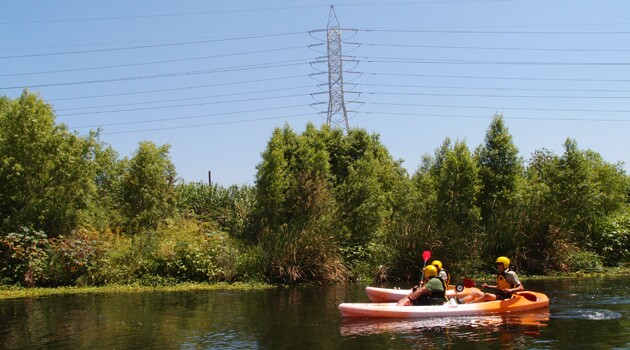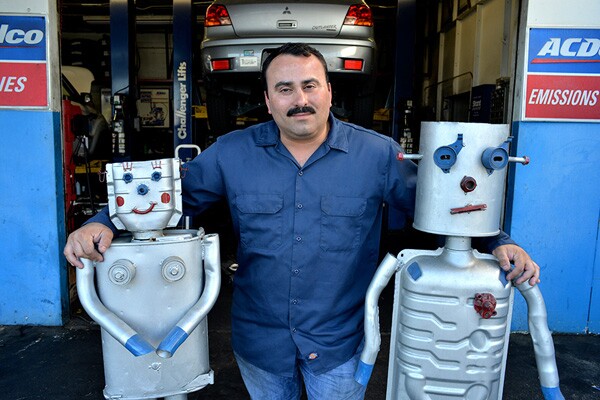8 Goals for Northeast Los Angeles Riverfront District Vision Plan

Enhancing a sense of place is the first in a series of eight goals for the Northeast Los Angeles Riverfront District Vision Plan and Economic Development Implementation Strategy (Vision Plan). The Vision Plan is the latest result of an effort that builds off the momentum to revitalize the Los Angeles River that has been revived over the past three decades.
The area of focus is the Glendale Narrows section of the river within Northeast Los Angeles, an ideal area for a planning grant because of the natural beauty of the river resulting from the riverbed's soft bottom. The core focus of this process was to engage the communities of the five river-adjacent neighborhoods (Atwater Village, Cypress Park, Elysian Valley, Glassell Park and Lincoln Heights) toward establishing a vision for the area that would leverage the river revitalization efforts to benefit its communities. In recognition of the increased development speculation around the river in the Northeast, this process seeks to elicit the opinions of existing community stakeholders.
The river winds its way past some of the city's most fascinating ecological, cultural and recreational terrain, presenting city residents a wonderful opportunity to connect the principles of healthy living with the goals of sustainable and livable communities. It is a valuable resource that connects some of Los Angeles' most diverse and underrepresented communities, crossing boundaries of race, class, human geography and physical landscape. Providing a unique landscape for civic engagement, the river offers Angelenos an outdoor place for respite, education and recreation with family and friends. The river also provides great potential to serve as a driver of equitable community and economic development.
Unfortunately, decades of neglect, coupled with the city's vigorous growth, have left the Los Angeles River draped in concrete and hidden in the shadows of our bustling city. During those years, the river's purpose morphed from being the natural lifeline of the city to a utilitarian form of flood protection.

However, there has been an intense planning effort since 2000 to revitalize the river and its surroundings. The Vision Plan is an exciting development that complements existing efforts to revitalize the river and Northeast Los Angeles — complementing the Los Angeles River Revitalization Master Plan, the U.S. Army Corps of Engineers L.A. River Ecological Restoration Study and the L.A. City Cornfield Arroyo Specific Plan. We hope that these combined efforts can assist government agencies, community organizations, private actors and the public with concepts and community informed planning ideas that will benefit the river and surrounding communities for many generations to come.
Through a concerted effort by citizens' groups, local governments and state agencies, the river has seen dramatic improvements. Parks and greenways have been developed along the river's edge, wetlands and wildlife habitats have been opened up for recreational uses, and vacant lots and brownfield sites have been converted to parks for some of Los Angeles' most underserved communities.
The aim of this Vision Plan is to continue the revitalization efforts by reconnecting the Northeast Los Angeles (NELA) community with the river, therefore creating a symbiotic partnership that boasts the values of equitable community and economic development. Our goal is to provide a framework for a shared community-wide vision that informs elected officials along with various city, state and federal agencies of future community, economic and recreational investment priorities.
The framework consists of goals and recommendations which largely addresses issues related to physical design and urban form with strong considerations of social, cultural, environmental and economic factors. The Vision Plan integrates a series of eight overarching goals complemented by recommendations for viable projects and prototypical development projects, policies and programs. This plan serves as a guide for the implementation of viable projects that will help revitalize the NELA area. Additionally, it provides a successful case study for the entire 51-mile stretch of the river. The Vision Plan goals include:
2. Enliven the riverfront open-space experience
3. Connect neighborhoods and river via enhanced mobility
4. Improve ecological health of the built environment
5. Strengthen and support employment opportunities
6. Improve governmental regulation and coordination of the river
7. Make space for social equity
8. Promote sustainable economic development
Successful implementation of these goal statements can help revitalize the river, green the adjacent neighborhoods, capture community opportunities and create value within the NELA community. This plan highlights placemaking as a key strategy, which directs energy toward building upon each neighborhood's unique attributes and uniting stakeholders to enhance the collective identity of the area.
Learn more about the Vision Plan's goals

Although the Vision Plan's purpose is to serve as a guide to make planning, policy and budgetary decisions that concern development within the NELA community, it does not explicitly define a horizon period for realization of all the proposed projects due to their long-term nature. The ability to carry out and successfully implement each recommendation will depend heavily on multiple changing factors, such as fluctuating economic conditions, the availability of resources and the willingness of the private sector to participate. The NELA Riverfront Collaborative acknowledges that decision-makers must consider varying factors such as project complexity and cost, community support, market conditions, financial feasibility, risk assessment and the ability to incentivize public-private partnerships and cooperation.
Overall, this plan is an informational document that does not contain any legislative authority to change the zoning or acquire any private properties that may be shown within this plan. The recommendations are only shown as examples for future analysis and shall not be construed as anything to the contrary.
This effort is led locally by the L.A. City Economic Workforce Development Department (EWDD) as part of the Northeast Los Angeles Riverfront Collaborative (NELA RC) and is funded by the federal Partnership for Sustainable Communities Community Planning Challenge Grant. Through the assemblage of an innovative and interdisciplinary collaborative of partners from public agencies, universities, community organizations, private enterprise, urban design and public media, the NELA RC has engaged the communities thorough various engagement activities to inform the production of the Vision Plan that unfolds in the following pages.





